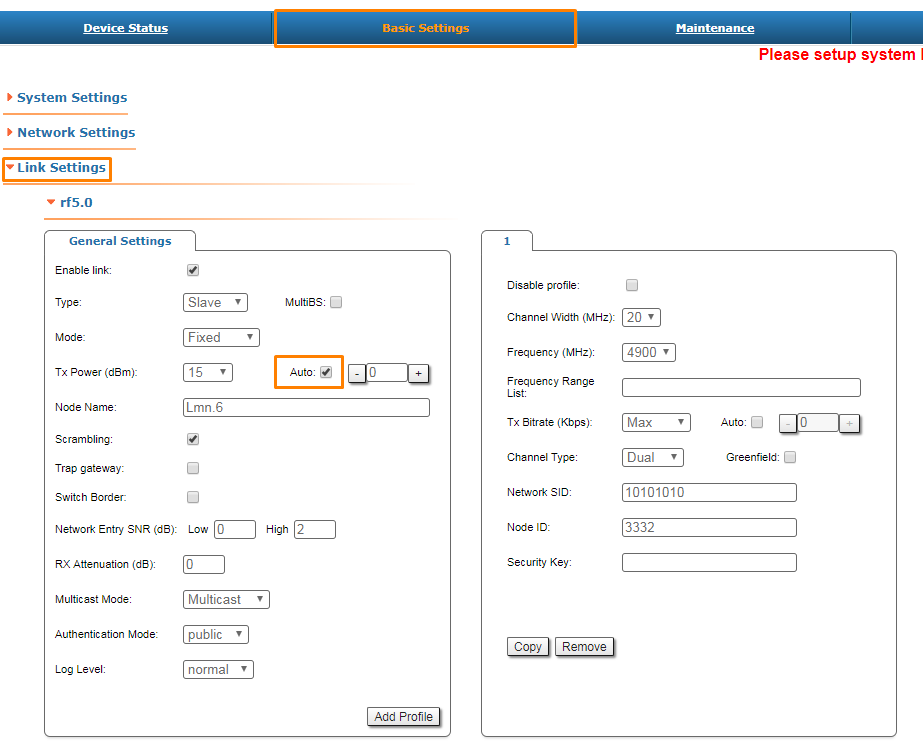...
| Hide_comments |
|---|
Firmware versions are identified using the corresponding abbreviation in the name:
- MINT - firmware with Polling technology support. For example, R5000-H08S01-MINTv190. 54.
- TDMA - firmware with TDMA technology support. For example, R5000-H08S11-TDMAv201. 34.
| Note | ||
|---|---|---|
| ||
"MINT" The Polling and " TDMA " firmware versions are not compatible. Upgrade from "MINT" to "TDMA" is recommended to start with version The upgrade from Polling to TDMA is recommended starting from the "MINTv1. 90. 25" version. |
TDMA limitations
- Supported hardware platforms: H05, H06, H07, H08, H11.
- It works only with MIMO devices.
- "transient" mode is not supported.
- It is recommended to use the same "TDMA" firmware version on all devices in the network.
- All synchronized master devices in sync mode with AUX-ODU-SYNC must have the following equal parameters:
- Frame Size
- DL/UL ratio.
- There are the following conditions of "TDMA" use in various channel width:
- Fully supported: 5, 10, 20, 40 MHz - fully supported.
- Operates3.5, 7, 30 MHz - operates, but there may be minor frame deviations : 3.5, 7, 30 MHz (with "Greenfield" mode enable).
- Not recommended for use: 14, 15, 30 MHz - not recommended for use.
- Fully inoperable: 28 MHz - fully inoperable.
- Recommended channel width in PtMP topology: 20 and 40 MHz (this . This is due to large overhead for the service information transmission in narrow channel width).
Upgrade from
...
Polling to TDMA procedure
"TDMA" firmware TDMA firmware must be installed on all involved in a radio connection devices. This process is better to start with the most distant from the access point devices.
...
- Automatic transmit power control ("ATPC" option).
In order to do this go to the section "Basic Settings" -> "Link Settings" in web-interface and check the box "Auto":
| Center | |||||
|---|---|---|---|---|---|
|
- Set the maximum possible transmit power in the field "Tx Power" .Click and click "Apply".
3) Download " TDMA " firmware from the ftp server: ftp://ftp.infinet.ru/pub/Firmware/beta/TDMA/ for the appropriate hardware platform.
4) Upload firmware on all devices: go to the section "Maintenance" -> "Upload", click "Choose File" in the field "Firmware", followed by the «Upload» button after the file has been picked up.
5) After clicking the «Upload» button, the system performs three operations: uploading, saving and validating the new file uploaded and indicates if each of the operation succeeded or failed. In case that the process succeeded, you have to reboot the unit in order to apply the new changes.
...
| Note | ||
|---|---|---|
| ||
All devices after upgrading to " TDMA " version becomes a Slave. The only exception will be a device with the enabled "Polling" option (command "mint pollstart"), which becomes the Master and has the following parameters by default:
After upgrade set the actual value of the "Max. Distance" parameter. |
7) Upgrade the device boot monitor for hardware platform "H08" (R5000-Omx/R5000-Mmx models) via command.
...
| Note | ||
|---|---|---|
| ||
"_upgrade -q" command is available starting with firmware version "MINTv1.90.17". It is recommended to install the firmware version not lower than "MINTv1.90.25" before the boot monitor upgrade. The command can be executed via a web interface in the section "Command Line". |
...
8) Set appropriate radio parameters. Setting should be performed on the Master device.
| Note | ||
|---|---|---|
| ||
Radio parameters setting is described in the section "How to upgrade your network from MINT to TDMARadio link settings in the time division access networks (TDMA technology)". |
| Note | ||
|---|---|---|
| ||
In the case of synchronization with AUX-ODU-SYNC, please perform settings described in the section "Connection to the synchronization unit". |
